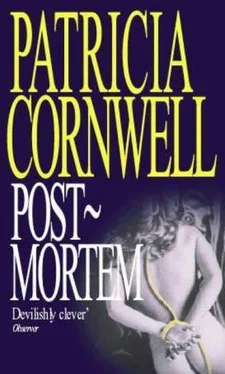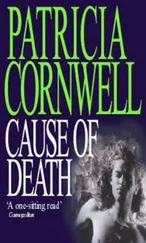Patricia Cornwell - Postmortem
Здесь есть возможность читать онлайн «Patricia Cornwell - Postmortem» весь текст электронной книги совершенно бесплатно (целиком полную версию без сокращений). В некоторых случаях можно слушать аудио, скачать через торрент в формате fb2 и присутствует краткое содержание. Жанр: Фантастика и фэнтези, на английском языке. Описание произведения, (предисловие) а так же отзывы посетителей доступны на портале библиотеки ЛибКат.
- Название:Postmortem
- Автор:
- Жанр:
- Год:неизвестен
- ISBN:нет данных
- Рейтинг книги:3 / 5. Голосов: 1
-
Избранное:Добавить в избранное
- Отзывы:
-
Ваша оценка:
- 60
- 1
- 2
- 3
- 4
- 5
Postmortem: краткое содержание, описание и аннотация
Предлагаем к чтению аннотацию, описание, краткое содержание или предисловие (зависит от того, что написал сам автор книги «Postmortem»). Если вы не нашли необходимую информацию о книге — напишите в комментариях, мы постараемся отыскать её.
Postmortem — читать онлайн бесплатно полную книгу (весь текст) целиком
Ниже представлен текст книги, разбитый по страницам. Система сохранения места последней прочитанной страницы, позволяет с удобством читать онлайн бесплатно книгу «Postmortem», без необходимости каждый раз заново искать на чём Вы остановились. Поставьте закладку, и сможете в любой момент перейти на страницу, на которой закончили чтение.
Интервал:
Закладка:
I glanced up at the wall clock. "He'll be here in ten minutes."
She stared at me for a long time. "What? What is it, exactly, you want me to do?"
"Use your journalistic connections to help us find him."
"Him?"
Her eyes widened.
I got up to see if there was any coffee left.
Wesley was reluctant when I had explained my plan over the telephone, but now that the three of us were in my office it seemed clear to me he'd accepted it.
"Your complete cooperation is non-negotiable," he said to Abby emphatically. "I've got to have your assurance you'll do exactly what we agree upon. Any improvisation or creative thinking on your part could blow the investigation right out of the water. Your discretion is imperative."
She nodded, then pointed out, "If it's the killer breaking into the computer, why's he done it only once?"
"Once we're aware of," I reminded her.
"Still, it hasn't happened again since you discovered it."
Wesley suggested, "He's been running like hell. He's murdered two women in two weeks and there's probably been sufficient information in the press to satisfy his curiosity. He could be sitting pretty, feeling smug, because by all news accounts we don't have anything on him."
"We've got to inflame him," I added. "We've got to do something to make him so paranoid he gets reckless. One way to do this is to make him think my office has found evidence that could be the break we've been waiting for."
"If he's the one getting into the computer," Wesley summarized, "this could be sufficient incentive for him to try again to discover what we supposedly know."
He looked at me.
The fact was we had no break in the case. I'd indefinitely banished Margaret from her office and the computer was to be left in answer mode. Wesley had set up a tracer to track all calls made to her extension. We were going to use the computer to lure the murderer by having Abby's paper print a story claiming the forensic investigation had come up with a "significant link."
"He's going to be paranoid, upset enough to believe it," I predicted. "If he's ever been treated in a hospital around here, for example, he's going to worry now that we might track him through old charts. If he gets any special medications from a pharmacy, he's got that to worry about, too."
All of this hinged on the peculiar odor Matt Petersen mentioned to the police. There was no other "evidence" to which we could safely allude.
The one piece of evidence the killer would have trouble with was DNA.
I could bluff him from hell to breakfast with it, and it might not even be a bluff.
Several days ago, I had gotten copies of the reports from the first two cases. I studied the vertical array of bands of varying shades and widths, patterns that looked remarkably like the bar codes stamped on supermarket packaged foods. There were three radioactive probes in each case, and the position of the bands in each probe for Patty Lewis's case was indistinguishable from the position of the bands in the three probes in Brenda Steppe's.
"Of course this doesn't give us his identity," I explained to Abby and Wesley. "All we can say is if he's black, then only one out of 135 million men theoretically can fit the same pattern. If he's Caucasian, only one out of 500 million men."
DNA is the microcosm of the total person, his life code. Genetic engineers in a private laboratory in New York had isolated the DNA from the samples of seminal fluid I collected. They snipped the samples at specific sites, and the fragments migrated to discrete regions of an electrically charged surface covered with a thick gel. A positively charged pole was at one end of the surface, a negatively charged pole at the other.
"DNA carries a negative charge," I went on. "Opposites attract."
The shorter fragments traveled farther and faster in the positive direction than the longer ones did, and the fragments spread out across the gel, forming the band pattern. This was transferred to a nylon membrane and exposed to a probe.
"I don't get it," Abby interrupted. "What probe?"
I explained. "The killer's double-stranded DNA fragments were broken, or denatured, into single strands. In more simplistic terms, they were unzipped like a zipper. The probe is a solution of single-stranded DNA of a specific base sequence that's labeled with a radioactive marker. When the solution, or probe, was washed over the nylon membrane, the probe sought out and bonded with complementary single strands-with the killer's complementary single strands."
"So the zipper is zipped back up?" she asked. "But it's radioactive now?"
"The point is that his pattern can now be visualized on X-ray film," I said.
"Yeah, his bar code. Too bad we can't run it over a scanner and come up with his name," Wesley dryly added.
"Everything about him is there," I continued. "The problem is the technology isn't sophisticated enough yet to read the specifics, such as genetic defects, eye and hair color, that sort of thing. There are so many bands present covering so many points in the person's genetic makeup it's simply too complex to definitively make anything more out of it than a match or a nonmatch."
"But the killer doesn't know that."
Wesley looked speculatively at me.
"That's right."
"Not unless he's a scientist or something," Abby interjected.
"We'll assume he isn't," I told them. "I suspect he never gave DNA profiling a thought until he started reading about it in the papers. I doubt he understands the concept very well."
"I'll explain the procedure in my story," Abby thought out loud. "I'll make him understand it just enough to freak him."
"Just enough to make him think we know about his defect," Wesley agreed. "If he has a defect… That's what worries me, Kay."
He looked levelly at me. "What if he doesn't?"
I patiently went over it again. "What continues to stand out to me is Matt Petersen's reference to 'pancakes,' to the smell inside the bedroom reminding him of pancakes, of something sweet but sweaty."
"Maple syrup," Wesley recalled.
"Yes. If the killer has a body odor reminiscent of maple syrup, he may have some sort of anomaly, some type of metabolic disorder. Specifically, 'maple syrup urine disease.'"
"And it's genetic?" Wesley had asked this twice.
"That's the beauty of it, Benton. If he has it, it's in his DNA somewhere."
"I've never heard of it," Abby said. "This disease."
"Well, it's not exactly your common cold."
"Then exactly what is it?"
I got up from my desk and went to a bookcase. Sliding out the fat Textbook of Medicine, I opened it to the right page and set it before them.
"It's an enzyme defect," I explained as I sat back down. "The defect results in amino acids accumulating in the body like a poison. In the classic or acute form, the person suffers severe mental retardation and/or death at infancy, which is why it's rare to find healthy adults of sound mind who suffer from the disease. But it's possible. In its mild form, which would have to be what the killer suffers from if this is his affliction, postnatal development is normal, symptoms are intermittent, and the disease can be treated through a low-protein diet, and possibly through dietary supplements-specifically, thiamine, or vitamin B1, at ten times the normal daily intake."
"In other words," Wesley said, leaning forward and frowning as he scanned the book, "he could suffer from the mild form, lead a fairly normal life, be smart as hell-but stink?"
I nodded. "The most common indication of maple syrup urine disease is a characteristic odor, a distinctive maple syrupy odor of the urine and perspiration. The symptoms are going to be more acute when he's under stress, the odor more pronounced when he's doing what stresses him most, which is committing these murders. The odor's going to get into his clothing. He's going to have a long history of being self-conscious about his problem."
Читать дальшеИнтервал:
Закладка:
Похожие книги на «Postmortem»
Представляем Вашему вниманию похожие книги на «Postmortem» списком для выбора. Мы отобрали схожую по названию и смыслу литературу в надежде предоставить читателям больше вариантов отыскать новые, интересные, ещё непрочитанные произведения.
Обсуждение, отзывы о книге «Postmortem» и просто собственные мнения читателей. Оставьте ваши комментарии, напишите, что Вы думаете о произведении, его смысле или главных героях. Укажите что конкретно понравилось, а что нет, и почему Вы так считаете.












